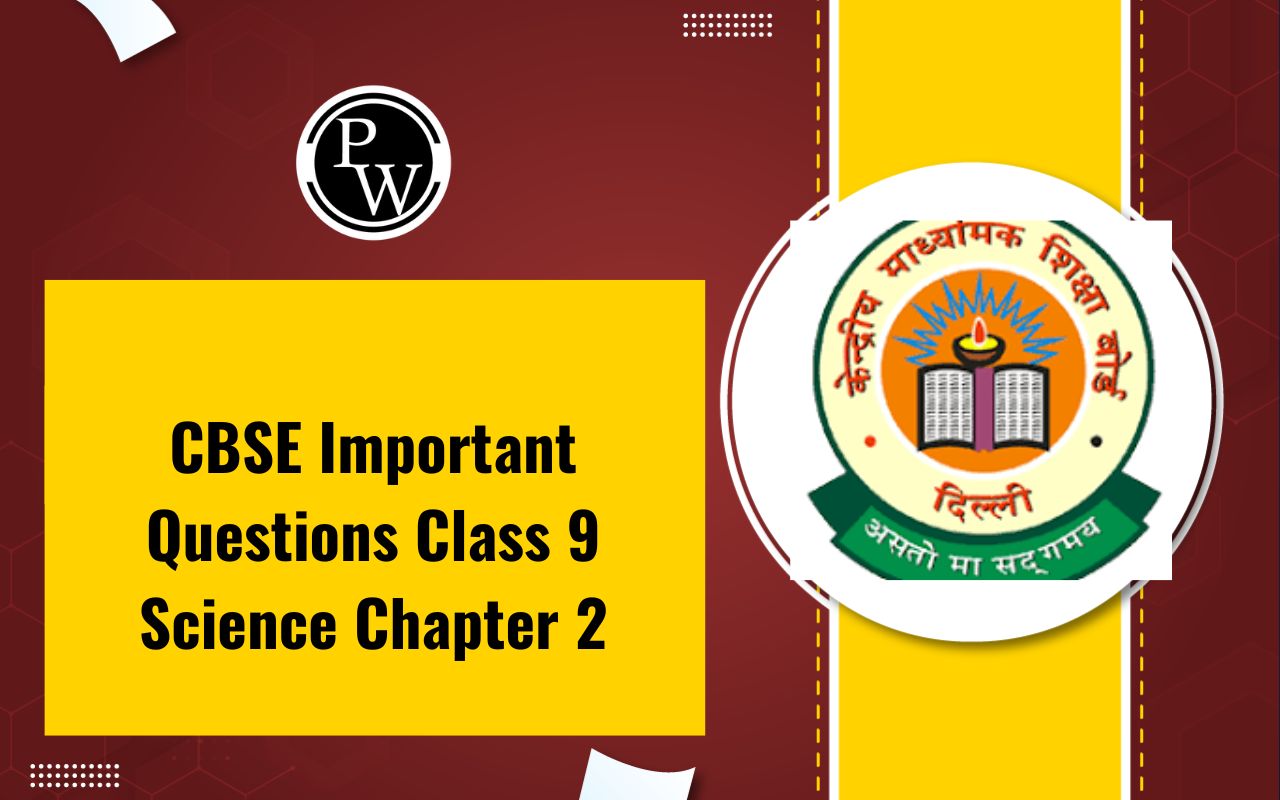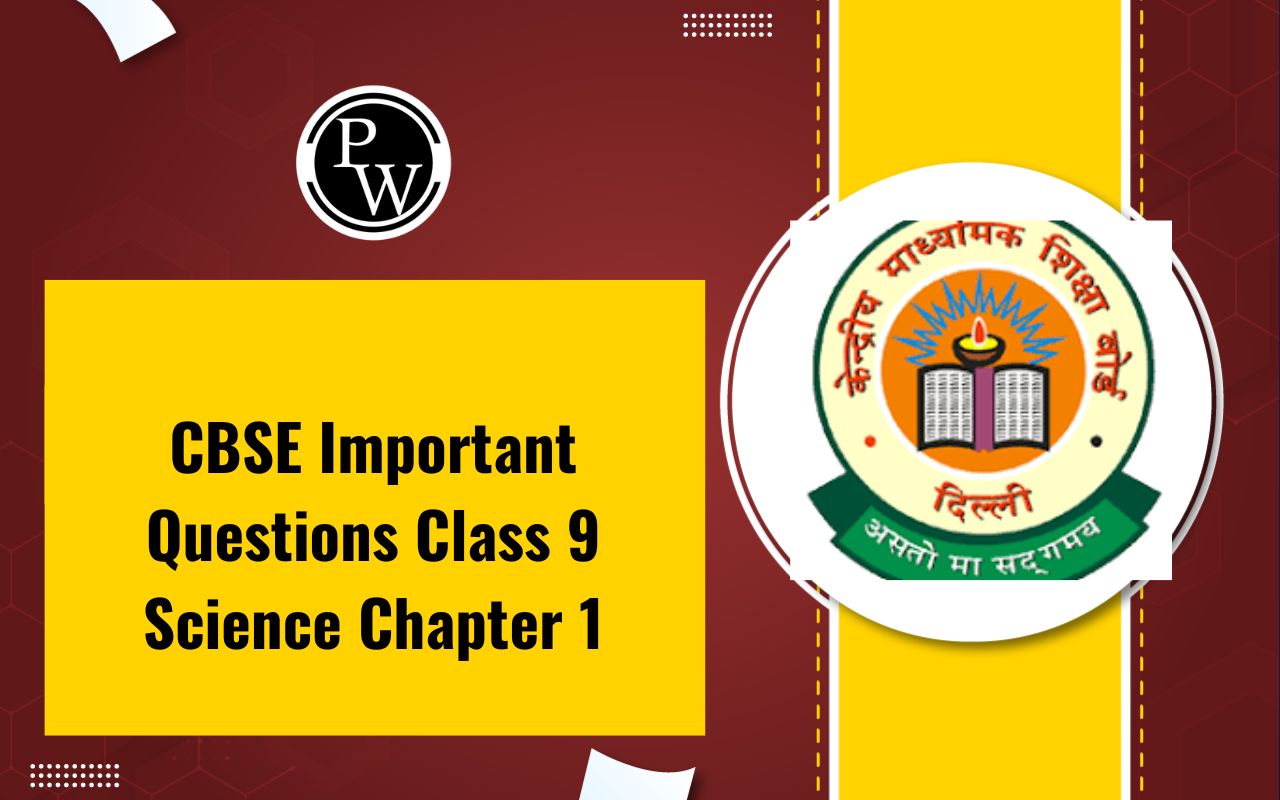
NCERT Solutions Class 9 Science Chapter 3 Atoms and Molecules Overview
The NCERT Solutions for Class 9 Science Chapter 3, "Atoms and Molecules," are created by subject experts of Physics Wallah. The solutions explain the basic structure of atoms, how they combine in chemical reactions, and important scientific laws related to them. These solutions are designed to help students understand these concepts easily and prepare well for their exams by providing clear explanations and examples.NCERT Solutions for Class 9 Science
NCERT Solutions for Class 9 Science Chapter 3 Atoms and Molecules PDF
You can find the PDF link for NCERT Solutions for Class 9 Science Chapter 3, "Atoms and Molecules," below. This PDF contains detailed solutions and explanations for understanding atoms, molecules, chemical reactions, and related scientific laws.NCERT Solutions for Class 9 Science Chapter 3 Atoms and Molecules PDF
NCERT Solutions for Class 9 Science Chapter 3 Atoms and Molecules
Atoms and molecules are fundamental units of matter in chemistry. Atoms are the smallest particles of an element that retain its properties, composed of protons, neutrons, and electrons. Molecules, on the other hand, are groups of atoms held together by chemical bonds. They can be made up of atoms of the same element (like O₂ for oxygen) or different elements (like H₂O for water). Understanding atoms and molecules is essential in chemistry as they form the basis for all chemical reactions and the structure of substances in the universe.NCERT Solutions for Class 9 Science Chapter 3 Exercise-3.1 Page: 32
Below we have provided NCERT Solutions for Class 9 Science Chapter 3 Atoms and Molecules for the ease of the students – 1. In a reaction, 5.3g of sodium carbonate reacted with 6 g of acetic acid. The products were 2.2 g of carbon dioxide, 0.9 g of water and 8.2 g of sodium acetate. Show that these observations are in agreement with the law of conservation of mass. Sodium carbonate + acetic acid → Sodium acetate + carbon dioxide + water Solution: According to law of conservation of mass: mass of reactants = mass of products Lets calculate and find out both results – mass of reactants = mass of sodium carbonate +mass of ethanoic acid = 5.3g + 6g = 11.3g mass of products = mass of sodium ethanoate + mass of carbon dioxide + mass of water = 8.2g +2.2g + 0.9g = 11.3g Hence it is proved that these observations are in agreement with the law of conservation of mass. 2. Hydrogen and oxygen combine in a ratio of 1:8 by mass to form water. What mass of oxygen gas would be required to react completely with 3 g of hydrogen gas? Solution:- The ratio of hydrogen to oxygen in water (H₂O) is 1:8 by mass.
- For every 1 gram of hydrogen, 8 grams of oxygen are required to form water.
- Therefore, if you have 3 grams of hydrogen gas, you would need 3 × 8 = 24 grams of oxygen to completely react with it.
NCERT Solutions for Class 9 Science Chapter 3 Atoms and Molecules Exercise-3.2 Page: 35
1. Define the atomic mass unit. Solution: An atomic mass unit (amu) is a standard unit of mass used in chemistry and physics to measure the mass of atoms and molecules. According to the definition, one atomic mass unit is equal to 1/12th of the mass of one atom of carbon-12. This specific choice of carbon-12 as the reference isotope is due to its stability and its relative abundance in nature. By defining the atomic mass unit in this way, scientists have a consistent basis for comparing the masses of different atoms and molecules on a relative scale. For example, the atomic mass of hydrogen is approximately 1 amu, while the atomic mass of oxygen is about 16 amu, relative to carbon-12. This unit is essential in calculations involving atomic and molecular masses, as well as in understanding the ratios of elements in compounds and reactions. 2. Why is it not possible to see an atom with the naked eyes? Solution:- Size of Atoms : Atoms are incredibly tiny measured in nanometers (nm). For instance, a hydrogen atom has a diameter of about 0.1 nanometers, while larger atoms like uranium can be over 0.5 nanometers in diameter. This minuscule size makes atoms too small to be seen with the naked eye or even with most optical microscopes.
- Existence of Atoms : With the exception of noble gases in certain conditions, atoms do not exist independently in nature. Instead, they form molecules by bonding with other atoms. For example, hydrogen and oxygen atoms bond to form water molecules (H₂O). This bonding is due to atoms' tendency to combine to achieve stable electron configurations.
NCERT Solutions for Class 9 Science Chapter 3 Atoms and Molecules Exercise-3.3-3.4 Page: 39
1. Write down the formulae of (i) sodium oxide (ii) aluminium chloride (iii) sodium sulphide (iv) magnesium hydroxide Solution: The following are the formulae: (i) sodium oxide – Na 2 O (ii) aluminium chloride – AlCl 3 (iii) sodium sulphide – Na 2 S (iv) magnesium hydroxide – Mg (OH) 2 2. Write down the names of compounds represented by the following formulae: (i) Al 2 (SO 4 ) 3 (ii) CaCl 2 (iii) K 2 SO 4 (iv) KNO 3 (v) CaCO 3 . Solution: Listed below are the names of the compounds for each of the following formulae: (i) Al 2 (SO 4 ) 3 – Aluminium sulphate (ii) CaCl 2 – Calcium chloride (iii) K 2 SO 4 – Potassium sulphate (iv) KNO 3 – Potassium nitrate (v) CaCO 3 – Calcium carbonate 3. What is meant by the term chemical formula? Solution: Chemical formulas are indeed used to represent the types and quantities of atoms that make up a compound or element. Each element is represented by a unique chemical symbol, typically one or two letters derived from its name in English or Latin. For example, "H" represents hydrogen, and "Cl" represents chlorine. In the case of hydrochloric acid (HCl), its chemical formula indicates that each molecule of hydrochloric acid contains one atom of hydrogen and one atom of chlorine. This notation simplifies the representation of complex substances, allowing scientists to easily communicate and understand the composition of compounds across various fields of chemistry and beyond. 4. How many atoms are present in a (i) H 2 S molecule and (ii) PO 4 3- ion? Solution: The number of atoms present is as follows: (i) H 2 S molecule has 2 atoms of hydrogen and 1 atom of sulphur hence 3 atoms in total. (ii) PO 4 3- ion has 1 atom of phosphorus and 4 atoms of oxygen hence 5 atoms in total.NCERT Solutions for Class 9 Science Chapter 3 Atoms and Molecules Exercise-3.5.1-3.5.2 Page: 40
1. Calculate the molecular masses of H 2 , O 2 , Cl 2 , CO 2 , CH 4 , C 2 H 6 , C 2 H 4 , NH 3 , CH 3 OH. Solution: To calculate the molecular masses of the given compounds, we sum the atomic masses of all atoms present in the molecule. Here are the calculations: H₂ (Hydrogen gas) :- Atomic mass of hydrogen (H) = 1 amu
- Molecular mass of H₂ = 2 × 1 = 2 amu
- Atomic mass of oxygen (O) = 16 amu
- Molecular mass of O₂ = 2 × 16 = 32 amu
- Atomic mass of chlorine (Cl) = 35.5 amu (approximately)
- Molecular mass of Cl₂ = 2 × 35.5 = 71 amu (approximately)
- Atomic mass of carbon (C) = 12 amu
- Atomic mass of oxygen (O) = 16 amu
- Molecular mass of CO₂ = 12 + 2 × 16 = 12 + 32 = 44 amu
- Atomic mass of carbon (C) = 12 amu
- Atomic mass of hydrogen (H) = 1 amu
- Molecular mass of CH₄ = 12 + 4 × 1 = 12 + 4 = 16 amu
- Atomic mass of carbon (C) = 12 amu
- Atomic mass of hydrogen (H) = 1 amu
- Molecular mass of C₂H₆ = 2 × 12 + 6 × 1 = 24 + 6 = 30 amu
- Atomic mass of carbon (C) = 12 amu
- Atomic mass of hydrogen (H) = 1 amu
- Molecular mass of C₂H₄ = 2 × 12 + 4 × 1 = 24 + 4 = 28 amu
- Atomic mass of nitrogen (N) = 14 amu
- Atomic mass of hydrogen (H) = 1 amu
- Molecular mass of NH₃ = 14 + 3 × 1 = 14 + 3 = 17 amu
- Atomic mass of carbon (C) = 12 amu
- Atomic mass of hydrogen (H) = 1 amu
- Atomic mass of oxygen (O) = 16 amu
- Molecular mass of CH₃OH = 12 + 4 × 1 + 16 = 12 + 4 + 16 = 32 amu
NCERT Solutions for Class 9 Science Chapter 3 Atoms and Molecules Exercise-3.5.3 Page: 42
1. If one mole of carbon atoms weighs 12grams, what is the mass (in grams) of 1 atom of carbon? Solution: Given: 1 mole of carbon weighs 12g 1 mole of carbon atoms = 6.022 x 10 23 The molecular mass of carbon atoms = 12g = an atom of carbon mass Hence, mass of 1 carbon atom = 12 / 6.022 x 10 23 = 1.99 x 10 -23 g 2. Which has more number of atoms, 100 grams of sodium or 100 grams of iron (given the atomic mass of Na = 23u, Fe = 56 u)? Solution: (a) In 100 grams of Na: m = 100g, Molar mass of Na atom = 23g, N 0 = 6.022 x 10 23 , N = ? N = (Given mass x N 0 )/Molar mass N = (100 x 6.022 x 10 23 )/ 23 N = 26.18 x 10 23 atoms (b) In 100 grams of Fe: m = 100 g, Molar mass of Fe atom = 56 g, N 0 = 6.022 x 10 23 , N = ? N = (Given mass x N 0 )/ Molar mass N = (100 x 6.022 x 10 23 )/ 56 N = 10.75 x 10 23 atoms Therefore, the number of atoms is more in 100 g of Na than in 100 g of Fe.NCERT Solutions for Class 9 Science Chapter 3 Atoms and Molecules Exercise Page: 43
1. A 0.24g sample of a compound of oxygen and boron was found by analysis to contain 0.096g of boron and 0.144g of oxygen. Calculate the percentage composition of the compound by weight. Solution: Given: Mass of the sample compound = 0.24g, mass of boron = 0.096g, mass of oxygen = 0.144g To calculate the percentage composition of the compound, Percentage of boron = mass of boron / mass of the compound x 100 = 0.096g / 0.24g x 100 = 40% Percentage of oxygen = 100 – percentage of boron = 100 – 40 = 60% 2. When 3.0g of carbon is burnt in 8.00 g of oxygen, 11.00 g of carbon dioxide is produced. What mass of carbon dioxide will be formed when 3.00g of carbon is burnt in 50.00 g of oxygen? Which law of chemical combination will govern your answer? Solution: When 3.0 g of carbon is burnt in 8.00 g of oxygen, 11.00 g of carbon dioxide is produced. Given that 3.0 g of carbon combines with 8.0 g of oxygen to give 11.0 of carbon dioxide. Find out We need to find out the mass of carbon dioxide that will be formed when 3.00 g of carbon is burnt in 50.00 g of oxygen. Solution First, let us write the reaction taking place here. C + O2 → CO2 As per the given condition, when 3.0 g of carbon is burnt in 8.00 g of oxygen, 11.00 g of carbon dioxide is produced. 3g + 8g →11 g ( from the above reaction) The total mass of reactants = mass of carbon + mass of oxygen =3g+8g =11g The total mass of reactants = Total mass of products Therefore, the law of conservation of mass is proved. Then, it also depicts that carbon dioxide contains carbon and oxygen in a fixed ratio by mass, which is 3:8. Thus, it further proves the law of constant proportions. 3 g of carbon must also combine with 8 g of oxygen only. This means that (50−8)=42g of oxygen will remain unreacted. The remaining 42 g of oxygen will be left un-reactive. In this case, too, only 11 g of carbon dioxide will be formed The above answer is governed by the law of constant proportions. 3. What are polyatomic ions? Give examples. Solution: Polyatomic ions are ions that contain more than one atom, but they behave as a single unit. Example: CO 3 2- , H 2 PO 4 – 4. Write the chemical formula of the following. (a) Magnesium chloride (b) Calcium oxide (c) Copper nitrate (d) Aluminium chloride (e) Calcium carbonate Solution: The following are the chemical formula of the above-mentioned list: (a) Magnesium chloride – MgCl 2 (b) Calcium oxide – CaO (c) Copper nitrate – Cu(NO 3 ) 2 (d) Aluminium chloride – AlCl 3 (e) Calcium carbonate – CaCO 3 5. Give the names of the elements present in the following compounds. (a) Quick lime (b) Hydrogen bromide (c) Baking powder (d) Potassium sulphate Solution: The following are the names of the elements present in the following compounds: (a) Quick lime – Calcium and oxygen (CaO) (b) Hydrogen bromide – Hydrogen and bromine (HBr) (c) Baking powder – Sodium, Carbon, Hydrogen, Oxygen (NaHCO 3 ) (d) Potassium sulphate – Sulphur, Oxygen, Potassium (K 2 SO 4 ) 6. Calculate the molar mass of the following substances. (a) Ethyne, C 2 H 2 (b) Sulphur molecule, S 8 (c) Phosphorus molecule, P 4 (Atomic mass of phosphorus =31) (d) Hydrochloric acid, HCl (e) Nitric acid, HNO 3 Solution: Listed below is the molar mass of the following substances: (a) Molar mass of Ethyne C 2 H 2 = 2 x Mass of C+2 x Mass of H = (2×12)+(2×1)=24+2=26g (b) Molar mass of Sulphur molecule S 8 = 8 x Mass of S = 8 x 32 = 256g (c) Molar mass of Phosphorus molecule, P 4 = 4 x Mass of P = 4 x 31 = 124g (d) Molar mass of Hydrochloric acid, HCl = Mass of H+ Mass of Cl = 1+35.5 = 36.5g (e) Molar mass of Nitric acid, HNO 3 =Mass of H+ Mass of Nitrogen + 3 x Mass of O = 1 + 14+ 3×16 = 63g 7. What is the mass of (a) 1 mole of nitrogen atoms? (b) 4 moles of aluminium atoms (Atomic mass of aluminium =27)? (c) 10 moles of sodium sulphite (Na 2 SO 3 )? Solution: The mass of the above-mentioned list is as follows: (a) Atomic mass of nitrogen atoms = 14u Mass of 1 mole of nitrogen atoms = Atomic mass of nitrogen atoms Therefore, the mass of 1 mole of nitrogen atom is 14g. (b) Atomic mass of aluminium =27u Mass of 1 mole of aluminium atoms = 27g 1 mole of aluminium atoms = 27g, 4 moles of aluminium atoms = 4 x 27 = 108g (c) Mass of 1 mole of sodium sulphite Na 2 SO 3 = Molecular mass of sodium sulphite = 2 x Mass of Na + Mass of S + 3 x Mass of O = (2 x 23) + 32 +(3x 16) = 46+32+48 = 126g Therefore, mass of 10 moles of Na 2 SO 3 = 10 x 126 = 1260g 8. Convert into a mole. (a) 12g of oxygen gas (b) 20g of water (c) 22g of carbon dioxide Solution: Conversion of the above-mentioned molecules into moles is as follows: (a) Given: Mass of oxygen gas=12g Molar mass of oxygen gas = 2 Mass of Oxygen = 2 x 16 = 32g Number of moles = Mass given / molar mass of oxygen gas = 12/32 = 0.375 moles (b) Given: Mass of water = 20g Molar mass of water = 2 x Mass of Hydrogen + Mass of Oxygen = 2 x 1 + 16 = 18g Number of moles = Mass given / molar mass of water = 20/18 = 1.11 moles (c) Given: Mass of carbon dioxide = 22g Molar mass of carbon dioxide = Mass of C + 2 x Mass of Oxygen = 12 + 2x 16 = 12+32=44g Number of moles = Mass given/ molar mass of carbon dioxide = 22/44 = 0.5 moles 9. What is the mass of: (a) 0.2 mole of oxygen atoms? (b) 0.5 mole of water molecules? Solution: The mass is as follows: (a) Mass of 1 mole of oxygen atoms = 16u; hence, it weighs 16g. Mass of 0.2 moles of oxygen atoms = 0.2 x 16 = 3.2g (b) Mass of 1 mole of water molecules = 18u; hence, it weighs 18g. Mass of 0.5 moles of water molecules = 0.5 x 18 = 9g 10. Calculate the number of molecules of sulphur (S 8 ) present in 16g of solid sulphur. Solution: To calculate the molecular mass of sulphur, Molecular mass of Sulphur (S 8 ) = 8xMass of Sulphur = 8×32 = 256g Mass given = 16g Number of moles = mass given/ molar mass of sulphur = 16/256 = 0.0625 moles To calculate the number of molecules of sulphur in 16g of solid sulphur, Number of molecules = Number of moles x Avogadro number = 0.0625 x 6.022 x 10²³ molecules = 3.763 x 10 22 molecules 11. Calculate the number of aluminium ions present in 0.051g of aluminium oxide. ( Hint: The mass of an ion is the same as that of an atom of the same element. Atomic mass of Al = 27u) Solution: To calculate the number of aluminium ions in 0.051g of aluminium oxide, 1 mole of aluminium oxide = 6.022 x 10 23 molecules of aluminium oxide 1 mole of aluminium oxide (Al 2 O 3 ) = 2 x Mass of aluminium + 3 x Mass of oxygen = (2x 27) + (3 x16) = 54 +48 = 102g 1 mole of aluminium oxide = 102g = 6.022 x 10 23 molecules of aluminium oxide Therefore, 0.051g of aluminium oxide has = 6.022 x 10 23 / 102 x 0.051 = 3.011 x 10 20 molecules of aluminium oxide One molecule of aluminium oxide has 2 aluminium ions; hence, the number of aluminium ions present in 0.051g of aluminium oxide = 2 x 3.011x 10 20 molecules of aluminium oxide. = 6.022 x 10 20Benefits of NCERT Solutions for Class 9 Science Chapter 3 Atoms and Molecules
- Concept Clarity : The solutions provide clear explanations and examples that help students understand the fundamental concepts of atoms, molecules, and their properties.
- Step-by-Step Guidance : Students receive structured step-by-step solutions that assist in solving problems related to atomic structure, chemical formulas, and calculations of molecular masses.
- Exam Preparation : NCERT Solutions are aligned with the CBSE curriculum, making them ideal for exam preparation. They cover all important topics and help students practice questions likely to appear in exams.
- Enhanced Problem-Solving Skills : By practicing with these solutions, students develop analytical and problem-solving skills essential for understanding chemical reactions and predicting outcomes.
- Application in Real Life : Understanding atoms and molecules helps students appreciate their significance in everyday life, from understanding household chemicals to complex industrial processes.
NCERT Solutions Class 9 Science Chapter 3 FAQs
What is an atom?
An atom is the smallest unit of matter that retains the properties of an element. It consists of a nucleus containing protons and neutrons, surrounded by electrons.
What is a molecule?
A molecule is a group of two or more atoms bonded together. It can be made up of atoms of the same element (like O₂ for oxygen) or different elements (like H₂O for water).
What is the difference between an atom and a molecule?
An atom is a single particle of an element, while a molecule is a group of atoms bonded together. Atoms are the basic building blocks of molecules.
How do atoms combine to form molecules?
Atoms combine to form molecules through chemical bonds, such as covalent bonds (sharing electrons) or ionic bonds (transfer of electrons). The way atoms bond determines the structure and properties of the molecule.
Talk to a counsellorHave doubts? Our support team will be happy to assist you!

Free Learning Resources
PW Books
Notes (Class 10-12)
PW Study Materials
Notes (Class 6-9)
Ncert Solutions
Govt Exams
Class 6th to 12th Online Courses
Govt Job Exams Courses
UPSC Coaching
Defence Exam Coaching
Gate Exam Coaching
Other Exams
Know about Physics Wallah
Physics Wallah is an Indian edtech platform that provides accessible & comprehensive learning experiences to students from Class 6th to postgraduate level. We also provide extensive NCERT solutions, sample paper, NEET, JEE Mains, BITSAT previous year papers & more such resources to students. Physics Wallah also caters to over 3.5 million registered students and over 78 lakh+ Youtube subscribers with 4.8 rating on its app.
We Stand Out because
We provide students with intensive courses with India’s qualified & experienced faculties & mentors. PW strives to make the learning experience comprehensive and accessible for students of all sections of society. We believe in empowering every single student who couldn't dream of a good career in engineering and medical field earlier.
Our Key Focus Areas
Physics Wallah's main focus is to make the learning experience as economical as possible for all students. With our affordable courses like Lakshya, Udaan and Arjuna and many others, we have been able to provide a platform for lakhs of aspirants. From providing Chemistry, Maths, Physics formula to giving e-books of eminent authors like RD Sharma, RS Aggarwal and Lakhmir Singh, PW focuses on every single student's need for preparation.
What Makes Us Different
Physics Wallah strives to develop a comprehensive pedagogical structure for students, where they get a state-of-the-art learning experience with study material and resources. Apart from catering students preparing for JEE Mains and NEET, PW also provides study material for each state board like Uttar Pradesh, Bihar, and others
Copyright © 2025 Physicswallah Limited All rights reserved.
Get App









